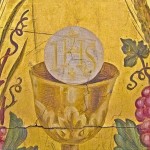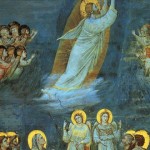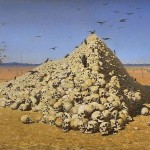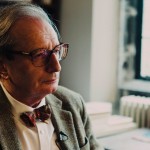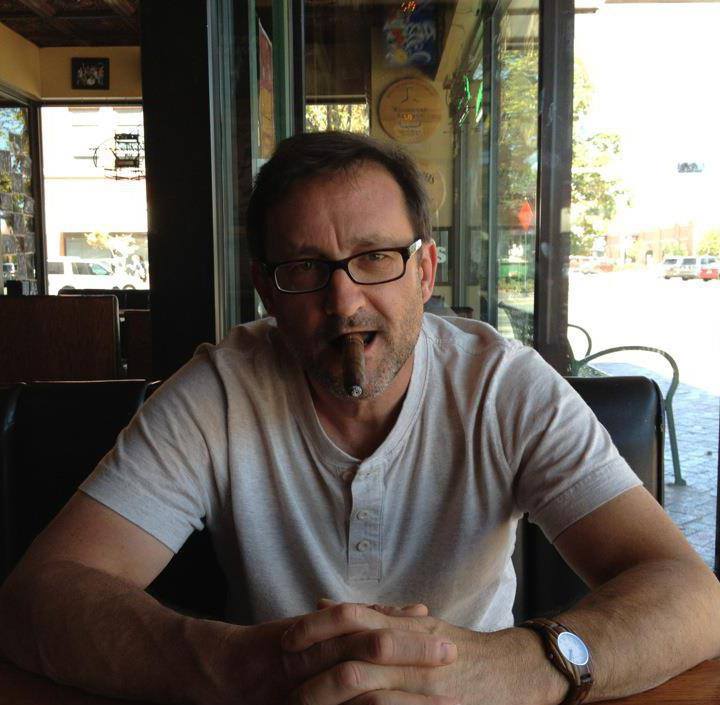
Today brings you an excerpt from an interview I recently conducted with theologian Larry Chapp. Larry has been involved in dialogues between scientists and theologians for goodness knows how long.
His book on that very topic, The God of Covenant and Creation, was featured in the very first Cosmos TOP10 list entitled “Top 10 Theology Books of the Last 10 Years (That I’ve Read).”
Our conversation grows out of questions readers directed at me after my widely circulated science and religion in dialogue post.
You can read the rest of the interview with Larry tomorrow on the Ethika Politika portal Rabelaisian Catholicism.
Cosmos the in Lost: I’d like to throw you a curveball. Please pardon the lack of theological rigor, but I wasn’t trained as a theologian. I’ve always had trouble reconciling the understanding of God (transcendent yet immanent) as ipsum esse and the person of Jesus Christ (immanent yet transcendent)–they live in separate compartments of my mind and come together only in short flashes of insight. You’ve thrown some bridges between those two perspectives in the answer above. What are some other ways of thinking about this connection with more clarity? What are some (if any) implications of rightly conceiving these theological conceptions for bridging divides between theology and science?
Larry Chapp: The Transcendence of God is precisely what makes his ubiquitous immanence possible. Non transcendent gods cannot be truly immanent but can only occupy a delimited space in space and time like the rest of us. As such they are all “local”. Even God viewed as a “supreme Being” at the top of a great chain of being remains implicated in the worldly order in a temporal and spatial way. Only a God who is wholly “Other” (aliud) can be the radically “non other” (non aliud). A truly Transcendent God is radically distinct from finitude which is precisely what makes his omnipresence in all finite things most intimately, possible. Thus, it is possible for a truly Transcendent God to be metaphysically “present” in our spatio-temporal world without for all that becoming localized. If this were not so, then when the second person of the Trinity was incarnated as the man Jesus, then for all the years he was “on the earth” he could not have been also still within the Godhead. The Incarnation will always remain a theological mystery in the strict sense since we are not capable of truly conceiving how the Infinite “works” and thus we are not capable of understanding the mechanics of the incarnation.
We must also pay attention to the addition to our understanding given by the Revelation of the Trinity. What this doctrine does is highlight that God’s “act” as pure Being is an act of relational love. God is not first God and only then differentiated into three persons, as if the divine nature were somehow antecedent to the relational persons. Rather, it is precisely the eternal, relational, circumincession of the persons within God that IS the divine nature. It is relationality all the way down so to speak. This was the insight of the modern trinitarian theologians like Balthasar, and Schindler is one of its best current expositors. Furthermore, because God is not a homogenous and static “unity” conceived of in the flat mathematical currency of “one” or “sameness”, but rather, a dynamic unity in distinction and distinction within unity, then it is possible to say that there is “otherness” within God, so long as we understand the proper analogical limits of saying that, and that the intra divine otherness is always already the very source of the divine unity as love. Thus, the otherness within God becomes the condition of possibility for God to posit a world – – a finite other – – with which to enter into relation ad extra. Thus is all worldly difference and distinction grounded in the Trinitarian otherness. Philosophers from time immemorial have grappled with this problem – – the problem of the one and the many – – and usually come away with a monistic reduction of worldly difference in the acid of the One (Plotinus). Thus does the world become a mere illusion (maya as the Hindus call it) or a place where all distinctions are viewed as a false dualism of consciousness (advaita in Buddhism) needing to be overcoming by dissolving all differences in the universal solvent of non-being. Only Christianity, therefore, can provide us with an ontology of Trinitarian love that properly grounds the world precisely as “world” and grounds worldly difference and distinctions in the realm of real being giving them standing. Christianity thus preaches the resurrection of the flesh, and a new heavens and a new earth – – not the reduction of all things at the end into the realm of illusory shadows. Christianity is therefore the most worldly of all world religions and is the only religion that can give us a true theology of creation as such. Christ is therefore, as Balthasar puts it, the “concrete universal” that shows us that that path to the truth is not in bypassing worldly structure and the realm of “things”, but in and through their mediation. As Balthasar puts it: Das Ganze im Fragment (the universal is mediated in and through the particular fragment).
That’s it for today. The rest of this answer and several more questions will be published tomorrow. In the meantime here are two of Larry’s favorite people together: Dylan and Papa Wojtyla.
====================================================
UPDATE: Here’s another excerpt and the direct link to the interview.


